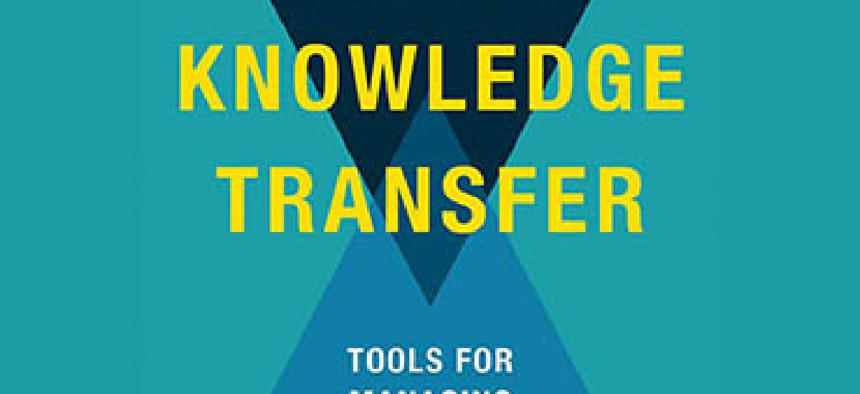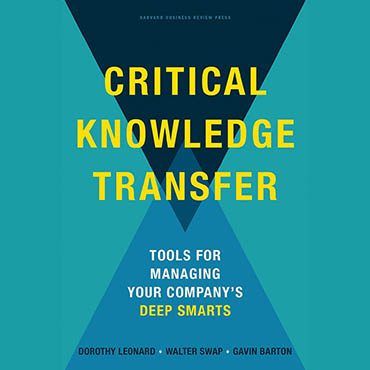Knowledge transfer through discovery

Rules and data are relatively easy to share, but capturing an organization's deep, experience-based knowledge requires special effort.

Excerpted from “Critical Knowledge Transfer: Tools for Managing Your Company’s Deep Smarts.” Copyright 2015 by Dorothy Leonard, Walter Swap and Gavin Barton. Reprinted by permission of Harvard Business Review Press.
A fully realized knowledge transfer initiative requires substantial resources — financial, time and personnel. Yet the need for expertise to be passed on, and the costs of not doing so, must be recognized. Most organizations do not have knowledge transfer built into their operations. Instead, they need to make special efforts to transfer know-how. (In our survey of CIOs, CTOs and HR executives, only 23 percent indicated that their organization had a specific program dedicated to knowledge transfer.)
In the face of a lack of resources, your temptation will likely be to resort to lectures by the experts to the learners as the most expeditious mode of transfer. You know that you can’t possibly re-create expert decision-making and diagnostic capabilities in learners’ minds that way. Yet those deep smarts are what your organization truly needs. And allowing the learner to actively discover the knowledge can be a very effective strategy.
An example of discovery in action
The U.S. Army’s Leader Challenge embodies active discovery in the classroom. An experienced military leader (usually through video, but sometimes in person) poses a dilemma that he or she has personally experienced in the field. Here’s an example: In Iraq, the U.S. platoon leader has been on an extended patrol and is returning to base when an improvised explosive device (IED) kills one of his soldiers. After personally carrying the dead soldier to the medevac helicopter, he receives an order from the company commander. The leader presents the challenge he faced to a class as follows:
“Coming back from an all-night foot patrol, Sgt. H. was hit by an IED. He didn’t make it. After getting him medevac’d out, I began thinking about what I was going to tell the platoon once we got back to our base. Then, the commander called and gave me a direct order to clear the nearest village, where the guys who put in the IED could be located — a mission that would easily take eight hours. My guys were out of food and water, were already physically smoked, and they were pissed off about Sgt. H. He was easily the men’s favorite team leader, and there’s no way those people [Iraqis] didn’t know about that IED. Then my trusted platoon sergeant tells me, “Sir, there is no way we can do that mission. Look at the guys!” At that point, my company commander called again to find out why I wasn’t moving to the village. What do I do?”
The classroom of learners now has the opportunity to discuss what to do, including thinking through potential second-order effects, both in the moment and long term. After exploring the possibilities and potential consequences of each action, the participants watch the second part of the video, which reveals what the platoon leader did. He occupied a building in the village where he took a tactical pause to refit with water and to explain to his men what [had] happened and what their new mission was. The platoon then conducted the mission and returned to base.
The objective of having the learners actively grapple with a complex issue such as this one before being told how it was resolved is to instill judgment — wise decision-making is a hallmark of deep smarts. Learners are warned that the solution reached in a particular case was not the only possible solution — perhaps not even the best. There is no way that the soldiers can be prepared for all contingencies by remembering specific solutions. But these learners will have to make such decisions quickly, using the best information available at the time; the Leader Challenge is a kind of simulation of the real world in which the soldiers will lead.
Feedback from participants included such statements as: “This works. How do I get more of these challenges?” Not only did the challenges build confidence in decision-making, but the exercise also helped the learners figure out what they didn’t know and where they had been overconfident.
Discovery exercises similar to the Army’s are deployed effectively in business settings as well. Using vignettes for training has produced a statistically significant improvement in situation awareness, sense making and planning skills. For example, Holly Baxter, the chief scientist at Strategic Knowledge Solutions, recounts a technique that begins with a subject-matter expert preparing a scenario of a situation that required a decision. The background and other relevant information were provided, but not the action taken by the subject-matter expert. The scenario was presented to the knowledge recipients, who shared with one another their thoughts, including the pros and cons of various possible decisions. Only then was the actual decision taken by the expert presented. Baxter describes this method as “a simple technique that puts students in the moment and gives surrogate experience, which enhances knowledge transfer.”
Simulations in the hands of individuals who have no real-world experience can lead to miscalculations. Product designers report saving lots of money avoiding the necessity of building physical prototypes by using simulations. At the same time, though, says Ashlee Vance, some critics see drawbacks in simulations:
“Design experts say they worry that young engineers now place too much emphasis on simulation and not enough on knowing how to build physical objects. Ultimately, it’s an engineer who establishes the constraints of the software, and setting the simulation parameters requires awareness of the physical world’s complexities. ‘[Practice with simulations] won’t make a bad engineer good,’ says Jim Cashman III, CEO of Ansys, the largest producer of simulation software. ‘It will make a good engineer great.’”
And that is what we are after — experience building that creates deep smarts. Computerized simulations employed to train airplane pilots or doctors in medical school build tacit knowledge through repeated, highly realistic experiences. Be thankful that the pilot on your next flight and the surgeon who replaces your knee, hip or heart had experience with simulations. Such simulations allow the user to accumulate vicarious experiences, from which learners will derive principles of decision-making and behavior and will develop the sensory skills that help build their expertise.
Software-based simulations are expensive to build and are not a likely option for transferring the deep smarts of a particular individual or group in your organization. However, discovery exercises like the Army’s Leader Challenge are well within your reach, given the ease of video creation.
We know of a worldwide construction company whose managers puzzled over how to transfer the expertise of their troubleshooters without constantly flying these experts around the world. One solution the managers came up with was to videotape common construction problems, such as water damage from inadequate preparation of walls. The YouTube-like video did not have high production value, but the stains and crumbling stucco from the problem were clearly visible. After some context was provided (climate, age), workers in far-flung regions of the company were asked to view the video, diagnose what had happened and suggest a remedy. Only then was the cause explained and the preventative steps demonstrated, again by video.
Similarly, in your organization you can create short text vignettes of dilemmas specific to your operations. The critical-incident technique we described in chapter 5 is also a form of simulation, although it does not have the element of discovery unless you take the story in pieces, asking at various points what those unfamiliar with the details might have done, what information they might have sought or whom they would have contacted. If you do so, the critical incident begins to approximate the cases that are used as text simulations in so many business school classrooms around the world.
Simulations, guided experience and discovery exercises all have the same objectives. First, they all build, through repeated decision-making, a repertoire of experiences and associated patterns on which learners can draw when considering possible responses. Second, these techniques all create a relatively safe environment in which to fail forward — that is, to learn from making wrong decisions without penalty to the learners themselves or others. Failure is highly memorable, so these experiences are a low-cost way to imprint system thinking — that is, to learn to anticipate possible implications of an action on others’ subsequent decisions and actions. Third, these techniques all create a sense of self-efficacy in the learners [and] enhanced confidence in their ability to address future situations and problems.
The effectiveness of all these methods is best determined by the ability of the learners to demonstrate expertise in the real world. The usual separation in time and situation between the learning process and its eventual outcome makes evaluation difficult — but not impossible.
NEXT STORY: Video: More Apps Are Taking on Maps


